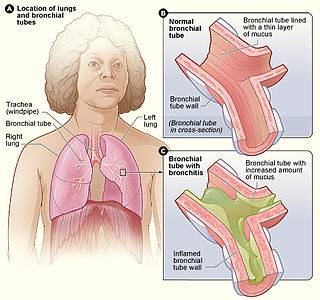
Environmental health is the branch of public health concerned with all aspects of the natural and built environment affecting human health. In order to effectively control factors that may affect health, the requirements that must be met in order to create a healthy environment must be determined. The major sub-disciplines of environmental health are environmental science, toxicology, environmental epidemiology, and environmental and occupational medicine.

Non-invasive ventilation (NIV) is the use of breathing support administered through a face mask, nasal mask, or a helmet. Air, usually with added oxygen, is given through the mask under positive pressure; generally the amount of pressure is alternated depending on whether someone is breathing in or out. It is termed "non-invasive" because it is delivered with a mask that is tightly fitted to the face or around the head, but without a need for tracheal intubation. While there are similarities with regard to the interface, NIV is not the same as continuous positive airway pressure (CPAP), which applies a single level of positive airway pressure throughout the whole respiratory cycle; CPAP does not deliver ventilation but is occasionally used in conditions also treated with NIV.

Respiratory diseases, or lung diseases, are pathological conditions affecting the organs and tissues that make gas exchange difficult in air-breathing animals. They include conditions of the respiratory tract including the trachea, bronchi, bronchioles, alveoli, pleurae, pleural cavity, the nerves and muscles of respiration. Respiratory diseases range from mild and self-limiting, such as the common cold, influenza, and pharyngitis to life-threatening diseases such as bacterial pneumonia, pulmonary embolism, tuberculosis, acute asthma, lung cancer, and severe acute respiratory syndromes, such as COVID-19. Respiratory diseases can be classified in many different ways, including by the organ or tissue involved, by the type and pattern of associated signs and symptoms, or by the cause of the disease.

Environmental issues in Nepal include a number of issues, such as deforestation, climate change, energy and species conservation. Many of these issues have been precipitated by rapid industrialization without major environmental regulation.

Disease burden is the impact of a health problem as measured by financial cost, mortality, morbidity, or other indicators. It is often quantified in terms of quality-adjusted life years (QALYs) or disability-adjusted life years (DALYs). Both of these metrics quantify the number of years lost due to disability (YLDs), sometimes also known as years lost due to disease or years lived with disability/disease. One DALY can be thought of as one year of healthy life lost, and the overall disease burden can be thought of as a measure of the gap between current health status and the ideal health status. According to an article published in The Lancet in June 2015, low back pain and major depressive disorder were among the top ten causes of YLDs and were the cause of more health loss than diabetes, chronic obstructive pulmonary disease, and asthma combined. The study based on data from 188 countries, considered to be the largest and most detailed analysis to quantify levels, patterns, and trends in ill health and disability, concluded that "the proportion of disability-adjusted life years due to YLDs increased globally from 21.1% in 1990 to 31.2% in 2013." The environmental burden of disease is defined as the number of DALYs that can be attributed to environmental factors. Similarly, the work-related burden of disease is defined as the number of deaths and DALYs that can be attributed to occupational risk factors to human health. These measures allow for comparison of disease burdens, and have also been used to forecast the possible impacts of health interventions. By 2014, DALYs per head were "40% higher in low-income and middle-income regions."
Yokkaichi asthma (四日市ぜんそく, Yokkaichi zensoku) refers to cases of chronic obstructive pulmonary disease, chronic bronchitis, pulmonary emphysema, and bronchial asthma in humans and various environmental changes usually attributed to sulfur dioxide (SO2) emissions which appeared as smog over the city of Yokkaichi in Mie Prefecture, Japan between 1960 and 1972, though other SOx compounds have been proposed. The generally accepted source of the sulfur oxide pollution was the Yokkaichi Kombinato petrochemical processing facilities and refineries built in Yokkaichi between 1959 and 1972 which did not properly desulfurize the high sulfur content in its crude oil. Yokkaichi asthma is considered one of the Four Big Pollution Diseases of Japan and was the subject of Japan's first court case related to pollution.

Air pollution is the contamination of air due to the presence of substances called pollutants in the atmosphere that are harmful to the health of humans and other living beings, or cause damage to the climate or to materials. It is also the contamination of the indoor or outdoor environment either by chemical, physical, or biological agents that alters the natural features of the atmosphere. There are many different types of air pollutants, such as gases, particulates, and biological molecules. Air pollution can cause diseases, allergies, and even death to humans; it can also cause harm to other living organisms such as animals and crops, and may damage the natural environment or built environment. Air pollution can be caused by both human activities and natural phenomena.

Bronchitis is inflammation of the bronchi in the lungs that causes coughing. Bronchitis usually begins as an infection in the nose, ears, throat, or sinuses. The infection then makes its way down to the bronchi. Symptoms include coughing up sputum, wheezing, shortness of breath, and chest pain. Bronchitis can be acute or chronic.

Obstructive lung disease is a category of respiratory disease characterized by airway obstruction. Many obstructive diseases of the lung result from narrowing (obstruction) of the smaller bronchi and larger bronchioles, often because of excessive contraction of the smooth muscle itself. It is generally characterized by inflamed and easily collapsible airways, obstruction to airflow, problems exhaling, and frequent medical clinic visits and hospitalizations. Types of obstructive lung disease include asthma, bronchiectasis, bronchitis and chronic obstructive pulmonary disease (COPD). Although COPD shares similar characteristics with all other obstructive lung diseases, such as the signs of coughing and wheezing, they are distinct conditions in terms of disease onset, frequency of symptoms, and reversibility of airway obstruction. Cystic fibrosis is also sometimes included in obstructive pulmonary disease.
Respiratory Health Association is a nonprofit organization located on Chicago's Near West Side.

An acute exacerbation of chronic obstructive pulmonary disease, or acute exacerbations of chronic bronchitis (AECB), is a sudden worsening of chronic obstructive pulmonary disease (COPD) symptoms including shortness of breath, quantity and color of phlegm that typically lasts for several days.

Chronic obstructive pulmonary disease (COPD) is a type of progressive lung disease characterized by long-term respiratory symptoms and airflow limitation. GOLD 2024 defined COPD as a heterogeneous lung condition characterized by chronic respiratory symptoms due to abnormalities of the airways and/or alveoli (emphysema) that cause persistent, often progressive, airflow obstruction.

Emphysema is any air-filled enlargement in the body's tissues. Most commonly emphysema refers to the enlargement of air spaces (alveoli) in the lungs, and is also known as pulmonary emphysema.
Environmental health policy is governmental action intended to prevent exposure to environmental hazards or "eliminate the effects of exposure to environmental hazards".
Peymané Adab is a British physician who is a Professor of Public Health at the University of Birmingham. She leads the Institute of Applied Health Research Chronic Disease Management Team. Adab investigates the epidemiology and management of obesity and chronic obstructive pulmonary disease.
Committee on the Medical Effects of Air Pollutants (COMEAP) is a group of scientific experts who provide independent and authoritative advice to the UK government on the health effects of air pollution. Its core members are typically senior academics or professionals drawn from fields such as atmospheric chemistry, environmental health, epidemiology, and toxicology; a single lay member helps to ensure the committee's technical work is accessible to the public.
Particulate pollution is pollution of an environment that consists of particles suspended in some medium. There are three primary forms: atmospheric particulate matter, marine debris, and space debris. Some particles are released directly from a specific source, while others form in chemical reactions in the atmosphere. Particulate pollution can be derived from either natural sources or anthropogenic processes.
Deborah (Debbie) Jarvis is a British professor of public health at the National Heart and Lung Institute, Imperial College London. She is an authority on the epidemiology of asthma in adults.
Francine Laden is an American epidemiologist who is Professor of Environmental Epidemiology at the Harvard T.H. Chan School of Public Health. Her research has investigated the environmental epidemiology of chronic disease. She serves as co-director of the Harvard University and Boston University center for research on environmental and social stressors in housing across the life course. Laden has also served on the United States Environmental Protection Agency advisory board.









